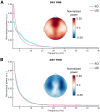The effect of sedation and time after cardiac arrest on coma outcome prognostication based on EEG power spectra
- PMID: 37469860
- PMCID: PMC10353761
- DOI: 10.1093/braincomms/fcad190
The effect of sedation and time after cardiac arrest on coma outcome prognostication based on EEG power spectra
Abstract
Early prognostication of long-term outcome of comatose patients after cardiac arrest remains challenging. Electroencephalography-based power spectra after cardiac arrest have been shown to help with the identification of patients with favourable outcome during the first day of coma. Here, we aim at comparing the power spectra prognostic value during the first and second day after coma onset following cardiac arrest and to investigate the impact of sedation on prognostication. In this cohort observational study, we included comatose patients (N = 91) after cardiac arrest for whom resting-state electroencephalography was collected on the first and second day after cardiac arrest in four Swiss hospitals. We evaluated whether the average power spectra values at 4.6-15.2 Hz were predictive of patients' outcome based on the best cerebral performance category score at 3 months, with scores ranging from 1 to 5 and dichotomized as favourable (1-2) and unfavourable (3-5). We assessed the effect of sedation and its interaction with the electroencephalography-based power spectra on patient outcome prediction through a generalized linear mixed model. Power spectra values provided 100% positive predictive value (95% confidence intervals: 0.81-1.00) on the first day of coma, with correctly predicted 18 out of 45 favourable outcome patients. On the second day, power spectra values were not predictive of patients' outcome (positive predictive value: 0.46, 95% confidence intervals: 0.19-0.75). On the first day, we did not find evidence of any significant contribution of sedative infusion rates to the patient outcome prediction (P > 0.05). Comatose patients' outcome prediction based on electroencephalographic power spectra is higher on the first compared with the second day after cardiac arrest. Sedation does not appear to impact patient outcome prediction.
Keywords: EEG; cardiac arrest; coma; early prognostication; sedation.
© The Author(s) 2023. Published by Oxford University Press on behalf of the Guarantors of Brain.
Conflict of interest statement
The authors report no competing interests.
Figures



Similar articles
-
Electroencephalography-based power spectra allow coma outcome prediction within 24 h of cardiac arrest.Resuscitation. 2019 Sep;142:162-167. doi: 10.1016/j.resuscitation.2019.05.021. Epub 2019 May 25. Resuscitation. 2019. PMID: 31136808
-
Background frequency can enhance the prognostication power of EEG patterns categories in comatose cardiac arrest survivors: a prospective, multicenter, observational cohort study.Crit Care. 2021 Nov 17;25(1):398. doi: 10.1186/s13054-021-03823-y. Crit Care. 2021. PMID: 34789304 Free PMC article.
-
Cerebral Recovery Index: Reliable Help for Prediction of Neurologic Outcome After Cardiac Arrest.Crit Care Med. 2017 Aug;45(8):e789-e797. doi: 10.1097/CCM.0000000000002412. Crit Care Med. 2017. PMID: 28430695
-
Brain imaging in comatose survivors of cardiac arrest: Pathophysiological correlates and prognostic properties.Resuscitation. 2018 Dec;133:124-136. doi: 10.1016/j.resuscitation.2018.09.012. Epub 2018 Sep 19. Resuscitation. 2018. PMID: 30244045 Review.
-
Clinical neurophysiologic monitoring and brain injury from cardiac arrest.Neurol Clin. 2006 Feb;24(1):89-106. doi: 10.1016/j.ncl.2005.11.003. Neurol Clin. 2006. PMID: 16443132 Review.
Cited by
-
Complex auditory regularity processing across levels of consciousness in coma: Stage 1 Registered Report.Brain Commun. 2024 Dec 21;7(1):fcae466. doi: 10.1093/braincomms/fcae466. eCollection 2025. Brain Commun. 2024. PMID: 39822953 Free PMC article.
References
-
- Virani SS, Alonso A, Aparicio HJ, et al. . Heart disease and stroke statistics-2021 update: A report from the American Heart Association. Circulation. 2021;143(8):e254–e743. - PubMed
-
- Nolan JP, Neumar RW, Adrie C, et al. . Post-cardiac arrest syndrome: Epidemiology, pathophysiology, treatment, and prognostication. A scientific statement from the International Liaison Committee on Resuscitation; the American Heart Association Emergency Cardiovascular Care Committee; the Council on Cardiovascular Surgery and Anesthesia; the Council on Cardiopulmonary, Perioperative, and Critical Care; the Council on Clinical Cardiology; the Council on Stroke. Resuscitation. 2008;79(3):350–379. - PubMed
-
- Stub D, Bernard S, Duffy SJ, Kaye DM. Post cardiac arrest syndrome: A review of therapeutic strategies. Circulation. 2011;123(13):1428–1435. - PubMed
-
- Dankiewicz J, Cronberg T, Lilja G, et al. . Hypothermia versus normothermia after out-of-hospital cardiac arrest. N Engl J Med. 2021;384(24):2283–2294. - PubMed
LinkOut - more resources
Full Text Sources
